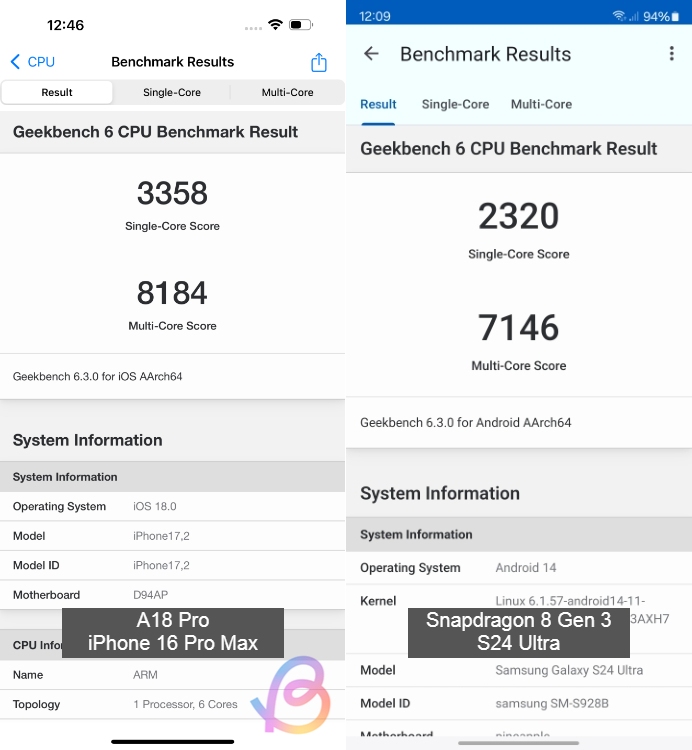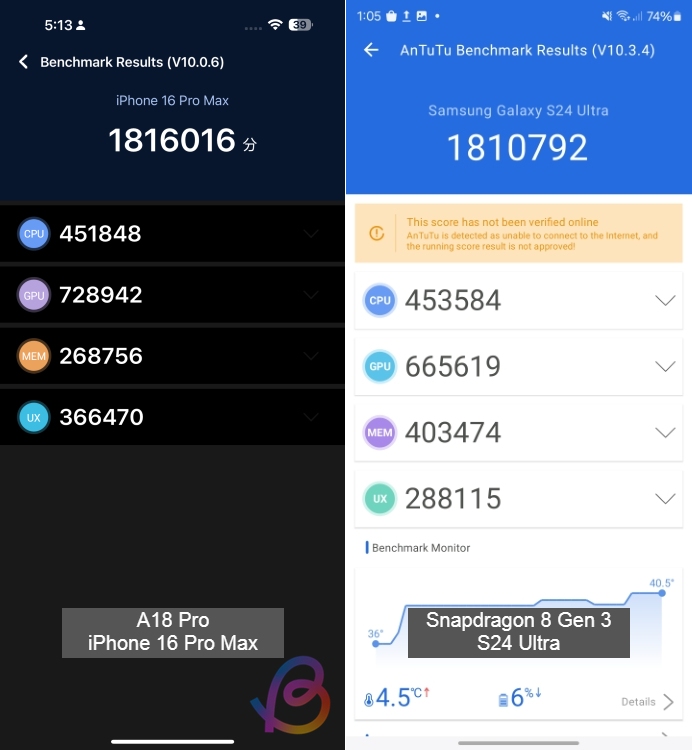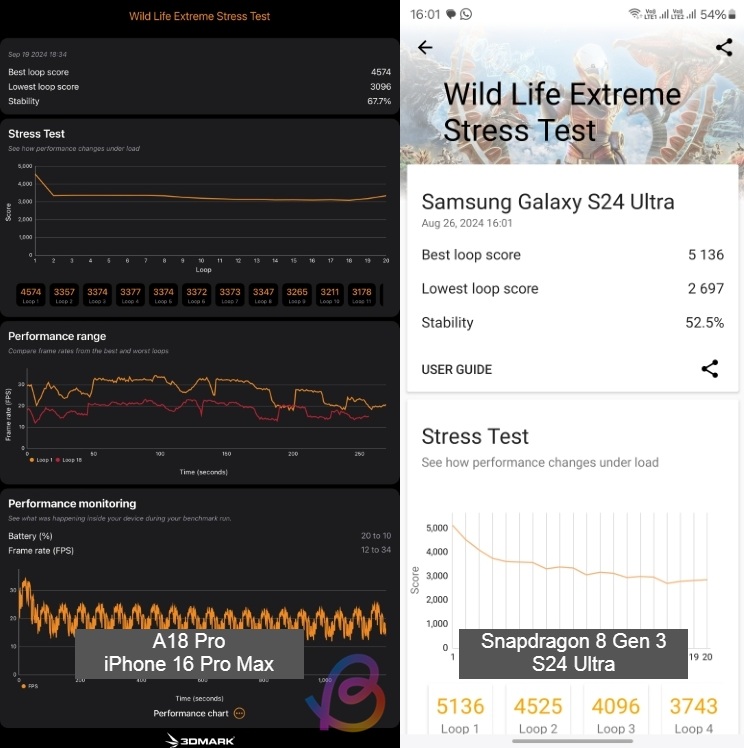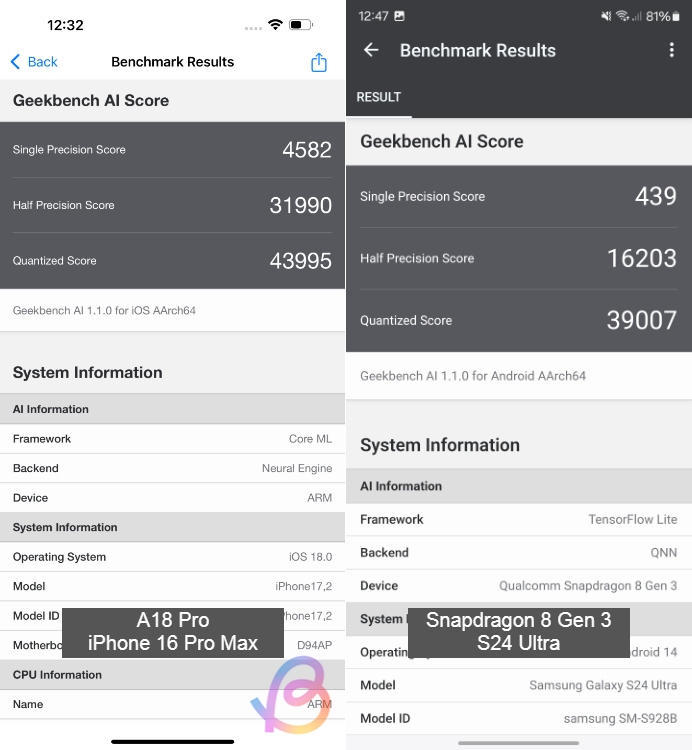Apple has released its flagship phones, the iPhone 16 Pro and 16 Pro Max, powered by the powerful A18 Pro chipset. The new A18 Pro chipset has been making headlines for its faster performance and unmatched efficiency. But how does it stack up against the Snapdragon 8 Gen 3, which remains the leading chipset in the Android world? To find out, let’s go through our detailed benchmark comparison between the A18 Pro and Snapdragon 8 Gen 3.
A18 Pro vs Snapdragon 8 Gen 3: Technical specifications
| Features | Apple A18 Pro | Snapdragon 8 Gen 3 |
|---|---|---|
| Processor | Six-core processor (2+4) | Kryo octa-core processor (1+3+2+2) |
| Processor Cores | 2 performance cores at 4.05 GHz 4 cores of 2.42 GHz efficiency | 1x 3.3 GHz (Cortex-X4) 3 x 3.2 GHz (Cortex-A720) 2 x 3.0 GHz (Cortex-A720) 2 x 2.3 GHz (Cortex-A520) |
| Process technology | TSMC’s 3nm process (N3E) | TSMC’s 4nm process (N4P) |
| GPU | Apple 6-core GPU Hardware accelerated ray tracing | Adreno 750 GPU HW Ray Tracing, AFME 2.0 Unreal Engine 5 Lumen Engine |
| Memory Support | LPDDR5X, up to 7500 MT/s | LPDDR5X, up to 4.8 GHz |
| Machine Learning and AI | 16-core Neural Engine; 35 TOPS | New Hexagon Artificial Intelligence Engine Run AI models up to 10 B parameters |
| Modem | Snapdragon X75 5G Modem Up to 10 Gbps peak download speed Up to 3.5 Gbps peak download speed | Snapdragon X75 5G Modem Up to 10 Gbps peak download speed Up to 3.5 Gbps peak download speed |
| Connectivity | Wi-Fi 7, Bluetooth 5.3 | Wi-Fi 7, Bluetooth 5.4, LE |
A18 Pro vs Snapdragon 8 Gen 3: Geekbench 6 processor

In the Geekbench CPU test, the A18 Pro scores 3,358 in single-core and 8,184 in multi-core. The A18 Pro processor is based on the Armv9.2a architecture and integrates two new SME units (ML accelerators) that help the processor achieve slightly better scores on the latest Geekbench 6.3 benchmark that recently received SME support.
For comparison, last year’s Snapdragon 8 Gen 3 scored 2,320 points in single-core and 7,146 points in multi-threaded. The processor is based on the older Armv8 architecture, so there is no SME support.
In summary, the A18 Pro processor is about 45% faster than the Snapdragon 8 Gen 3 in single-core tasks. And in terms of multi-core performance, it is 14% faster. Given that the Snapdragon 8 Gen 3 has eight CPU cores (the A18 Pro has six), the gap in terms of multi-core performance is not that huge.
A18 Pro vs Snapdragon 8 Gen 3: AnTuTu comparison

In the AnTuTu benchmark, the A18 Pro and Snapdragon 8 Gen 3 perform similarly. In our test, the A18 Pro scored 1,826,016 points and the Snapdragon 8 Gen 3 scored 1,810,792 points. The CPU performance is almost identical, but in terms of GPU, the A18 Pro offers 10% better graphics performance.
| AnTuTu Reference | A18 Pro | Snapdragon 8 Gen 3 |
|---|---|---|
| AnTuTu Score | 1 816 016 | 1 810 792 |
| Processor | 451 848 | 453 584 |
| GPU | 728 942 | 665 619 |
| Memory | 268,756 | 403 474 |
| UX | 366 470 | 288 115 |
A18 Pro vs Snapdragon 8 Gen 3: 3DMark Wild Life Extreme Stress Test

Next, in our 3DMark Wild Life Extreme Stress test, the 6-core A18 Pro GPU scored the best loop score of 4,574 points and the lowest loop score of 3,096 points with stability of 67.7%. While the Adreno 750 GPU on Snapdragon 8 Gen 3 scored the best in the first loop with a score of 5,136 points. But after several rounds, the lowest score dropped to 2,697 points. The stability settled at a lower level of 52.5%.
This means that the Snapdragon 8 Gen 3 can quickly improve GPU performance, but it can’t maintain peak performance for longer. The A18 Pro, on the other hand, offers sustained graphics performance over an extended time. Simply put, the A18 Pro will deliver a better gaming experience over a longer time than the Snapdragon 8 Gen 3.
| 3DMark Wild Life Extreme Stress Test | A18 Pro | Snapdragon 8 Gen 3 |
|---|---|---|
| Best loop score | 4,574 | 5 136 |
| Lowest loop score | 3,096 | 2,697 |
| Stability | 67.7% | 52.5% |
A18 Pro vs Snapdragon 8 Gen 3: Geekbench AI

Finally, we come to our Geekbench AI test which evaluates the Neural Engine/NPU. Geekbench AI was recently updated to version 1.1 which slightly improves scores across the board. It also added support for TensorFlow Lite and the QNN framework for Android devices. The NNAPI framework is deprecated and you finally get an accurate comparison between Android and iOS devices.
In our tests, the A18 Pro performed much better on the Single Precision (FP32) data type, achieving 4,582 points, while the Snapdragon 8 Gen 3 could only achieve 439 points. The full precision format offers higher accuracy when performing AI/ML tasks, but consumes more memory.
In Half Precision (FP16), the 16-core A18 Pro Neural Engine delivers 2x the performance of the Snapdragon 8 Gen 3’s Hexagon AI Engine. Finally, in Quantized (INT8) which is more memory-efficient but relatively less accurate, the A18 Pro is about 13% faster than the Snapdragon 8 Gen 3.
Apple is the leader in on-device AI computing. With the new SME units in the processor, the A18 Pro seems like a much better chipset for delivering AI/ML features locally.
| Geekbench AI | A18 Pro | Snapdragon 8 Gen 3 |
|---|---|---|
| Simple Accuracy Score | 4,582 | 439 |
| Half-accuracy score | 31,990 | 16 203 |
| Quantified score | 43,995 | 39 007 |
The verdict
It is obvious that the A18 Pro is a better chipset than the Snapdragon 8 Gen 3 in every way, be it CPU, GPU, or Neural Engine/NPU. Apple has the most powerful and power-efficient CPU cores and the GPU also delivers sustained graphics performance. When it comes to AI tasks on the device, Apple has once again proven that it is the industry leader.
Now all we have to do is wait for the Snapdragon 8 Gen 4, powered by Oryon, which promises exceptional performance. From the leaks so far, Qualcomm is about to surpass Apple in the processor department for the first time. The Snapdragon 8 Gen 4 will be released next month at the Snapdragon Summit event.
Related Articles:
Neverness to Everness (NTE) Release Date Prediction: When Will NTE Come Out?








